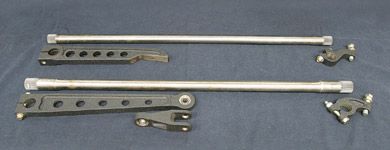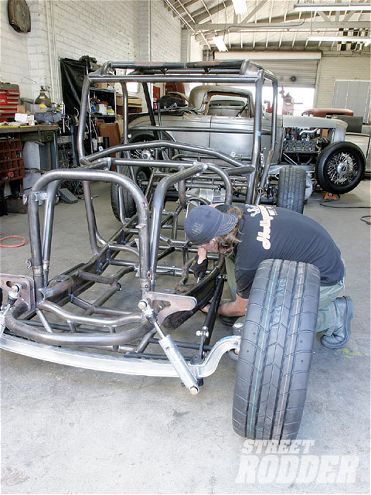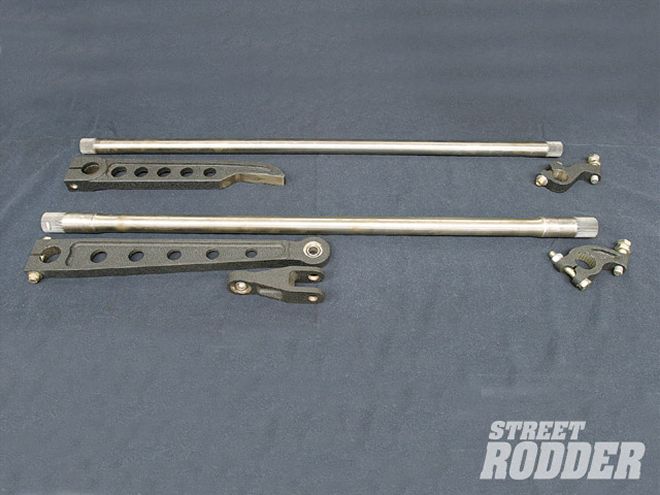

There are a number of ways in which to suspend a hot rod, but few designs offer a more compact, versatile, and adjustable design than that of the torsion bar variety. While on one hand the traditional Ford transverse leaf spring and straight axle design has merit, when it comes to adjustability and performance, it definitely leaves something to be desired. An IFS design on the other hand makes up for the transverse spring and straight axle's shortcomings when it comes to performance, but as an aesthetically pleasing design on a traditional hot rod, it fails miserably. Both of these designs, however, lack the compact packaging and adjustability of a torsion bar suspension system. Sure, you can replace the springs in a coil over IFS or straight axle suspension system to change the suspension characteristics, but you'd be hard-pressed to get more than an inch in adjustability when it comes to changing the ride height, something done with a torsion bar system with ease.
But just what is a torsion bar suspension system? Basically, it's a suspension design that uses a torsion bar, that is, a length of spring steel that consistently returns to its original position after being distorted (twisted), as its main, weight-bearing spring. One end of the bar is held in place firmly to the chassis while the other end is attached to a perpendicular lever that attaches to the axle, suspension arm, or spindle. Vertical motion of the axle causes the torsion bar to twist around its axis and is resisted by the bar's torsion resistance. The spring rate of this style of suspension system is determined by the length and diameter of the bar and by the length of the fulcrum points of the arm.
The torsion bar suspension design has been used by many automotive manufactures, including Volkswagen and Chrysler, and remains to this day the choice of a vast number of race teams from Sprint Cars to Formula One. The reason for this is the compact design, simplicity, and ease of adjustability the torsion bar system provides. Simply swapping out different diameter bars or changing the fulcrum points on the arms can change the entire handling and suspension characteristics of a given car, something that can make or break a team on race day.
 Here are the components for both the front and rear torsion bars for one side of the chassis. This is the combination that the crew at Moal Coachbuilders and Gary Schroeder at Schroeder Racing Parts came up with to suit a typical highboy roadster and the same setup Moal uses on their Road Champ Chassis.
Here are the components for both the front and rear torsion bars for one side of the chassis. This is the combination that the crew at Moal Coachbuilders and Gary Schroeder at Schroeder Racing Parts came up with to suit a typical highboy roadster and the same setup Moal uses on their Road Champ Chassis.
These benefits are cast onto our hobby in any number of ways. For one, a typical transverse spring, straight axle suspension system has no easy method of height adjustment. You're stuck with the height of the spring and whatever axle will fit without getting the car too low. Add to that the drawback of an elevated roll center as compared to a well-designed torsion bar suspension setup due to the spring-over-axle design. Moving the spring in front of or behind the axle, while it can lower the car when the chassis is designed for such a setup, will likely cause interference problems with the tie rod. An IFS or coilover-equipped suspension design is similarly ill-equipped for drastic changes when it comes to ride or handling quality and height adjustments. While swapping the coil springs can change the spring rate, one would be hard-pressed to make any significant height adjustments.
With the benefits and differences covered, let's take a look at what it takes to achieve a properly setup torsion bar suspension system. First off, one needs to decide how to lay out the bars themselves and how much room is available. On a solid axle car, this is usually done by mounting the front bars parallel to the framerails and the rear bars perpendicular, or transverse, to the framerails. This allows the use of fairly long torsion bars up front without interfering with the engine and steering components, and since most chassis are wider at the rear of the car and usually incorporate a kick up in front of the rear end, it makes sense to mount the rear bars in a transverse manner. The length of torsion bar used therefore is often determined by the space available on the given vehicle. The next detail to be tackled is the length of the arms that will actuate the torsion bars. But before that, it's important to figure out the weight of the vehicle, front and rear, and get a baseline spring rate to get started.
In a torsion bar suspension system, spring rate is defined as the amount of force required to move the torsion arm one inch, measured in pounds. For example, a torsion bar with a 100lb spring rate requires 100lbs of pressure to move the arm one inch. But changing the length and diameter of the torsion bar as well as the length or fulcrum points of the arm can change the spring rate. For example, if we were to take a one-inch by 28-inch solid torsion bar with a diameter of 0.725-inch and attach a 12-inch arm to it, the spring rate would be 90.26lbs. By adding a shorter arm, say 8-inches, the spring rate jumps up to 203.1lbs. If we increase the leverage and add a 16-inch arm, the spring rate drops to 50.77lbs. Likewise, if we change the diameter of the bar itself, the spring rate changes as well, so as you can see, there are a few ways to achieve the same spring rate, but with very different results when it comes to suspension characteristics and handling aspects. For example, a longer torsion bar yields a more gradual rate rise as the arm is required to travel a further distance to "wind" it up. This results in a bar that reacts slower due to the fact that the rising spring rate, the tendency of the bar to get stiffer the more it is wound, is higher than that of a shorter bar.
Hollywood Hot Rods had been toying with the torsion bar chassis idea for some time and when Ron Lee swung by the shop with an idea about building a roadster pickup for the famous La Carrera Panamericana race in Mexico, they agreed that a chassis with a torsion bar suspension design would be ideal. To get the ball rolling, Troy Ladd, head honcho over at HHR, made a phone call to Moal Coachbuilders, whose Road Champ chassis have been featured prominently under such cars as the AMBR-winning Sedueced and uses Schroeder Racing Products torsion bar suspension components. Together they pointed Troy in the right direction to get the components needed to provide them with a baseline spring rate that they can dial in at a later date if need be. Taking the guesswork out of the equation, the HHR crew was free to concentrate on the fabrication of the chassis and the mounting of the suspension components.